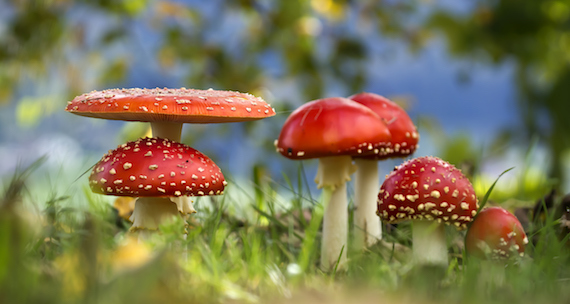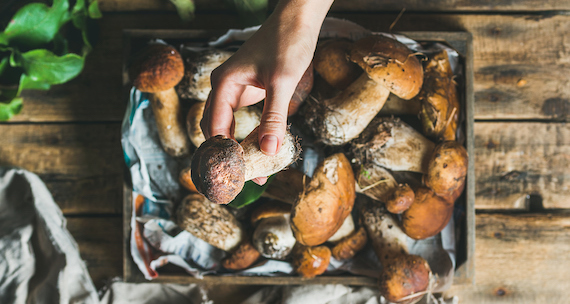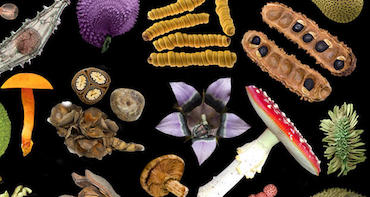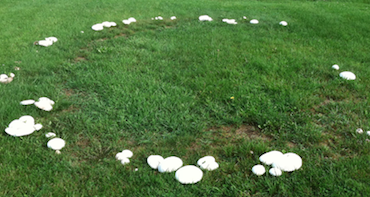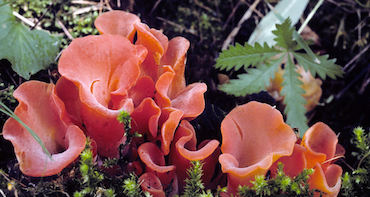Symbioses
Ecology
Fun With Fungi
The leaf-cutting ants of Central and South America create their food supply by forming a mutually beneficial association with certain fungi. They grow these fungi on gardens created from piles of disks they have cut from living leaves.
Ant Gardens
The leaf-cutting ants of Central and South America create their food supply by forming a mutually beneficial association with certain fungi. They grow these fungi on gardens created from piles of disks they have cut from living leaves.
Fun With Fungi
Diversity
Biodiversity was first defined as taxonomic diversity – the number of species. More recently, biodiversity has been broadened to include biological and geographic entities such as genetic diversity, taxonomic diversity and biogeographic diversity.
Biodiversity | Herbarium
Biodiversity was first defined as taxonomic diversity – the number of species. More recently, biodiversity has been broadened to include biological and geographic entities such as genetic diversity, taxonomic diversity and biogeographic diversity.
Fun With Fungi
Mushroom Collecting
Medical Mycology
In the old days, Chinese people thought that the caterpillar fungus were worms. However, after years of study, it was found that it really is a fruiting body produced by the fungus, Cordyceps sinesis, on dead caterpillars of the moth Hepilus fabricius.
Caterpillar Fungus | Herbarium
In the old days, Chinese people thought that the caterpillar fungus were worms. However, after years of study, it was found that it really is a fruiting body produced by the fungus, Cordyceps sinesis, on dead caterpillars of the moth Hepilus fabricius.
Fun With Fungi
Young Readers
Diversity
These fungi make beautiful coral-like mushrooms. They are spectacular when they fruit in large numbers on the forest floor. Single large mushrooms up to 50 pounds in weight are impressive. Colors include white, yellow, orange, red, purple, or tan.
Club & Coral Fungi | Herbarium
These fungi make beautiful coral-like mushrooms. They are spectacular when they fruit in large numbers on the forest floor. Single large mushrooms up to 50 pounds in weight are impressive. Colors include white, yellow, orange, red, purple, or tan.
Fun With Fungi
Mushroom Collecting
Many people safely enjoy eating wild mushrooms, but mycologiests are sometimes asked to identify mushrooms suspected in cases of posoning. The following guidelines and instructions are intended to help mushroom collectors have safe and profitable forays.
Collect and Identify
Many people safely enjoy eating wild mushrooms, but mycologiests are sometimes asked to identify mushrooms suspected in cases of posoning. The following guidelines and instructions are intended to help mushroom collectors have safe and profitable forays.
Fun With Fungi
Mycology: Study of Fungi
Mycologists collect or are given mushrooms and other fungi as part of their research. Research collections result when these fungi are dried and saved. Research collections contain an enormous amount of historical and potential information.
Data Warehouses | Herbarium
Mycologists collect or are given mushrooms and other fungi as part of their research. Research collections result when these fungi are dried and saved. Research collections contain an enormous amount of historical and potential information.
Fun With Fungi
Ecology
Decay and Decomposition
Economic Uses
Certain species of fungi and bacteria are the engines of the process of decomposition. When plants grow and produce new leaves, fruits, and stem wood, they use scarce nutrients like nitrogen to make the new tissues.
Decomposition | Herbarium
Certain species of fungi and bacteria are the engines of the process of decomposition. When plants grow and produce new leaves, fruits, and stem wood, they use scarce nutrients like nitrogen to make the new tissues.
Spore Dispersal
Fun With Fungi
Ecology
Fungi and plants are sessile (immobile). Unlike animals they cannot walk or fly to new habitats. Their immobility generally leaves only two ways for fungi and plants to extend their range: they can grow into an adjoining area, or disperse spores or seeds.
Dispersal | Herbarium
Fungi and plants are sessile (immobile). Unlike animals they cannot walk or fly to new habitats. Their immobility generally leaves only two ways for fungi and plants to extend their range: they can grow into an adjoining area, or disperse spores or seeds....
Young Readers
Decay and Decomposition
Spore Dispersal
Fun With Fungi
Diversity
Earthstars belong to a group of fungi called Gasteromycetes, or "stomach fungi". Their fruiting bodies are a stomach-shaped sac filled with dry spores. They are related to puffballs. Young, closed earthstars are onion-shaped.
Earth Stars | Herbarium
Earthstars belong to a group of fungi called Gasteromycetes, or "stomach fungi". Their fruiting bodies are a stomach-shaped sac filled with dry spores. They are related to puffballs. Young, closed earthstars are onion-shaped.
Decay and Decomposition
Fun With Fungi
Ecology
The name fairy ring comes from an old folk-tale. People once believed that mushrooms growing in a circle followed the path made by fairies dancing in a ring. Fairy rings are found in open grassy places and in forests.
Fairy Rings | Herbarium
The name fairy ring comes from an old folk-tale. People once believed that mushrooms growing in a circle followed the path made by fairies dancing in a ring. Fairy rings are found in open grassy places and in forests.
Fun With Fungi
Medical Mycology
Pathogenic fungi cause disease by parasitizing their plant, animal or human host. In humans, some of these fungi are normally present on, or in, our bodies and only cause a problem when the bodily defenses that control them are weakened or damaged.
Fungal Endocarditis: A Disease of the Heart | Herbarium
Pathogenic fungi cause disease by parasitizing their plant, animal or human host. In humans, some of these fungi are normally present on, or in, our bodies and only cause a problem when the bodily defenses that control them are weakened or damaged.
Fun With Fungi
Decay and Decomposition
Economic Uses
Fungi have been used for thousands of years to modify foods and beverages. Bread made without yeast fungi is flat. The addition of yeast to flat bread dough causes the dough to rise during baking. The result is the soft texture we associate with bread.
Fungal Factories: Gasohol and More | Hebarium
Fungi have been used for thousands of years to modify foods and beverages. Bread made without yeast fungi is flat. The addition of yeast to flat bread dough causes the dough to rise during baking. The result is the soft texture we associate with bread.
Symbioses
Economic Uses
Fun With Fungi
Ecology
Fungi that parasitize insects are a valuable weapon for biocontrol. The spores of a parasitic fungus are sprayed on the pest insects. The fungal attack takes place in three stages: entry into the host, growth, and spore production by the mature fungus.
Fungal Terminators: Bicontrol | Herbarium
Fungi that parasitize insects are a valuable weapon for biocontrol. The spores of a parasitic fungus are sprayed on the pest insects. The fungal attack takes place in three stages: entry into the host, growth, and spore production by the mature fungus.
Decay and Decomposition
Spore Dispersal
Diversity
Fun With Fungi
Medical Mycology
Young Readers
Giant puffballs are found in the central and eastern USA and Canada. During late Summer and Fall, look for them in meadows, under small stands of trees, and around forest openings. Puffballs are round or pear-shaped fruiting bodies that contain spores.
Giant Puffballs | Herbarium
Giant puffballs are found in the central and eastern USA and Canada. During late Summer and Fall, look for them in meadows, under small stands of trees, and around forest openings. Puffballs are round or pear-shaped fruiting bodies that contain spores.
Mushroom Collecting
Diversity
Economic Uses
Symbioses
Fun With Fungi
A truffle is, in the simplest terms, a fungus or mushroom of the genus Tuber. It grows underground, typically near or right beneath the roots of trees, particularly oak, beech, birch, poplars and pine trees. They form a symbiotic relationship.
Gold in the Soil: Truffles | Herbarium
A truffle is, in the simplest terms, a fungus or mushroom of the genus Tuber. It grows underground, typically near or right beneath the roots of trees, particularly oak, beech, birch, poplars and pine trees. They form a symbiotic relationship.
Fun With Fungi
Diversity
Jelly fungi make rubbery, seaweed-like mushrooms. They are white, orange, pink, rose, brown or black. They can be shapeless, shaped like cups, like railroad spikes or branched like coral. The common name of yellow to orange species is witches butter.
Jelly Fungi | Herbarium
Jelly fungi make rubbery, seaweed-like mushrooms. They are white, orange, pink, rose, brown or black. They can be shapeless, shaped like cups, like railroad spikes or branched like coral. The common name of yellow to orange species is witches butter.
Ecology
Economic Uses
Symbioses
Diversity
Fun With Fungi
The plant-like appearance of lichens hides their true identity. A lichen is not a single organism, but the result of a partnership (mutualistic symbiosis) between a fungus and an alga or cyanobacteria. Some lichens are formed of three or more partners.
Lichens | Herbarium
The plant-like appearance of lichens hides their true identity. A lichen is not a single organism, but the result of a partnership (mutualistic symbiosis) between a fungus and an alga or cyanobacteria. Some lichens are formed of three or more partners.
Fun With Fungi
Authors Dr. Robert Fogel and Patricia Rogers. Bob Fogel received his Ph.D. from Oregon State University in 1975 and was hired by the University of Michigan in 1978. Patricia Rogers received her B.A. in Literature from Wayne State University in 1978.
Meet the Authors | Herbarium
Authors Dr. Robert Fogel and Patricia Rogers. Bob Fogel received his Ph.D. from Oregon State University in 1975 and was hired by the University of Michigan in 1978. Patricia Rogers received her B.A. in Literature from Wayne State University in 1978.
Economic Uses
Fun With Fungi
Medical Mycology
Antibiotics are chemicals created as part of the life process of one organism, which can kill or stop the growth of a disease-causing microbe. Many of you are here only because penicillin saved your life or the life of one of your parents or grandparents.
Penicillin: The First Miracle Drug | Hebarium
Antibiotics are chemicals created as part of the life process of one organism, which can kill or stop the growth of a disease-causing microbe. Many of you are here only because penicillin saved your life or the life of one of your parents or grandparents....
Spore Dispersal
Mushroom Collecting
Fun With Fungi
Diversity
Decay and Decomposition
Morels are the fruiting body of a fungus that lives in the soil. When the soil temperature and moisture conditions are right the fungus produces morels, containing the spores of the fungus. The wind carries the spores to new habitats.
Pitted Delights: Morel Mushrooms | Herbarium
Morels are the fruiting body of a fungus that lives in the soil. When the soil temperature and moisture conditions are right the fungus produces morels, containing the spores of the fungus. The wind carries the spores to new habitats.
Fun With Fungi
These fungi make shelves or brackets to produce spores above the ground. They are known as polypores because the spore producing cells line pores. The pores make them different from other mushrooms. They also differ in not having a stem or a short stem.
Shelf Fungi | Herbarium
These fungi make shelves or brackets to produce spores above the ground. They are known as polypores because the spore producing cells line pores. The pores make them different from other mushrooms. They also differ in not having a stem or a short stem.
Diversity
Fun With Fungi
Symbioses
A bright yellow slimy blob is commonly seen in the summer on mulched flower beds. It is not pretty, unless you like yellow, and it soon gets uglier. The yellow blob turns gray, becomes hard, then breaks down into a brown powder.
The Blob: Slime Molds | Herbarium
A bright yellow slimy blob is commonly seen in the summer on mulched flower beds. It is not pretty, unless you like yellow, and it soon gets uglier. The yellow blob turns gray, becomes hard, then breaks down into a brown powder.
Diversity
Mycology: Study of Fungi
Fun With Fungi
Fungi are not plants. Living things are organized for study into large groups called kingdoms. Fungi were listed in the Plant Kingdom for years. Then scientists learned that fungi show a closer relation to animals, but are unique and separate life forms.
What are Fungi? | Herbarium
Fungi are not plants. Living things are organized for study into large groups called kingdoms. Fungi were listed in the Plant Kingdom for years. Then scientists learned that fungi show a closer relation to animals, but are unique and separate life forms.
Fun With Fungi
Mycology: Study of Fungi
First, not all organisms have a common name. In the Fungi, many species live in the soil and escape notice in everyday life. Others are not edible, or, at this time, not economically important, and are ignored.
Whats in a Name? | Herbarium
First, not all organisms have a common name. In the Fungi, many species live in the soil and escape notice in everyday life. Others are not edible, or, at this time, not economically important, and are ignored.



